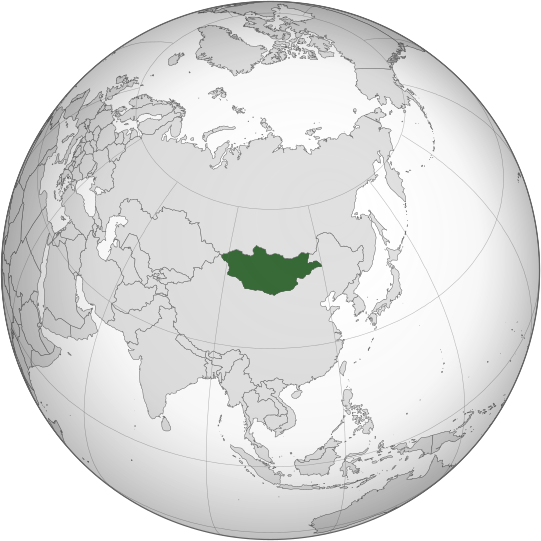The nomads of Mongolia sustain their lives directly from the products of domesticated animals such as cattle, horses, camels, yaks, sheep, and goats, and sometimes game.[1] Meat is either cooked, used as an ingredient for soups or dumplings (buuz/khuushuur/bansh), or dried for winter (borts).[1] The Mongolian diet includes a large proportion of animal fat which is necessary for the Mongols to withstand the cold winters and their hard work. Winter temperatures as low as -40 °C and outdoor work require sufficient energy reserves. Milk and cream are used to make a variety of beverages, as well as cheese and similar products.[2]
The nomads on the countryside are self-supporting by principle. Travellers will find yurts marked as "guanz" in regular intervals near the roadside, which operate as simple restaurants. In the yurt, which is a portable dwelling structure, Mongolians usually cook in a cast-iron or aluminium pot on a small stove, using wood or dried animal dung (argal) as fuel.
The most common rural dish is cooked mutton, often without any other ingredients. In the city, every other locale displays a sign saying "buuz". Those are dumplings filled with meat, which are cooked in steam. Other types of dumplings are boiled in water ("Bansh"), or deep fried in mutton fat ("Khuushuur"). Other dishes combine the meat with rice or fresh noodles into various stews (tsuivan, budaatai huurga) or noodle soups (guriltai shol).
The most surprising cooking method is only used on special occasions. In this case, the meat (often together with vegetables) gets cooked with the help of stones, which have been preheated in a fire. This either happens with chunks of mutton in a sealed milk can ("Khorkhog"), or within the abdominal cavity of a deboned goat or marmot ("Boodog").
Milk is boiled to separate the cream (öröm, clotted cream).[2] The remaining skimmed milk is processed into cheese ("byaslag"), dried curds (aaruul), yoghurt, kefir, as well as a light milk liquor ("Shimiin Arkhi"). The most prominent national beverage is airag, fermented mare's milk.[2] A popular cereal is barley, which is fried and malted. The resulting flour (arvain guril) is eaten as a porridge in milk fat and sugar or drunk mixed in milk tea. The everyday beverage is salted milk tea ("Süütei Tsai"), which may turn into a robust soup by adding rice, meat, or Bansh. As a consequence of the Russian influence during socialism, vodka also has gained some popularity[2] with a surprising number of local brands (usually grain spirits).
Horse meat is eaten in Mongolia and can be found in grocery stores.
The nomads on the countryside are self-supporting by principle. Travellers will find yurts marked as "guanz" in regular intervals near the roadside, which operate as simple restaurants. In the yurt, which is a portable dwelling structure, Mongolians usually cook in a cast-iron or aluminium pot on a small stove, using wood or dried animal dung (argal) as fuel.
The most common rural dish is cooked mutton, often without any other ingredients. In the city, every other locale displays a sign saying "buuz". Those are dumplings filled with meat, which are cooked in steam. Other types of dumplings are boiled in water ("Bansh"), or deep fried in mutton fat ("Khuushuur"). Other dishes combine the meat with rice or fresh noodles into various stews (tsuivan, budaatai huurga) or noodle soups (guriltai shol).
The most surprising cooking method is only used on special occasions. In this case, the meat (often together with vegetables) gets cooked with the help of stones, which have been preheated in a fire. This either happens with chunks of mutton in a sealed milk can ("Khorkhog"), or within the abdominal cavity of a deboned goat or marmot ("Boodog").
Milk is boiled to separate the cream (öröm, clotted cream).[2] The remaining skimmed milk is processed into cheese ("byaslag"), dried curds (aaruul), yoghurt, kefir, as well as a light milk liquor ("Shimiin Arkhi"). The most prominent national beverage is airag, fermented mare's milk.[2] A popular cereal is barley, which is fried and malted. The resulting flour (arvain guril) is eaten as a porridge in milk fat and sugar or drunk mixed in milk tea. The everyday beverage is salted milk tea ("Süütei Tsai"), which may turn into a robust soup by adding rice, meat, or Bansh. As a consequence of the Russian influence during socialism, vodka also has gained some popularity[2] with a surprising number of local brands (usually grain spirits).
Horse meat is eaten in Mongolia and can be found in grocery stores.
Ok, so the gist of that stuff up there is "they eat a lot of high-fat meat because it's really freaking cold there". As much as I wish I could claim "it's really freaking cold here" as an excuse to eat more calories, I don't think it's as cold in NH as it needs to be to justify eating fatty meats daily. Given that the majority of "authentic" Mongolian recipes I've found have been pretty consistently simply meat, maybe rolled in dough and boiled/steamed/fried, I think I'm going to get creative this week and might only do a couple "authentic" variations on "meat".
Here's the only source I've found that seems to be truly authentic Mongolian cooking. I think I'll pick two recipes and try them and fill the rest of the week with familiar stuff. I'll let you know how it goes.

Very wise of you :)
ReplyDelete